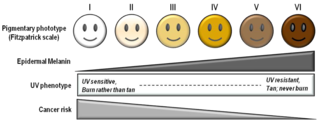


The Fitzpatrick scale (also Fitzpatrick skin typing test; or Fitzpatrick phototyping scale) is a numerical classification schema for human skin color. It was developed in 1975 by American dermatologist Thomas B. Fitzpatrick as a way to estimate the response of different types of skin to ultraviolet (UV) light.[2] It was initially developed on the basis of skin color to measure the correct dose of UVA for PUVA therapy, and when the initial testing based only on hair and eye color resulted in too high UVA doses for some, it was altered to be based on the patient's reports of how their skin responds to the sun; it was also extended to a wider range of skin types.[3][4][5] The Fitzpatrick scale remains a recognized tool for dermatological research into human skin pigmentation.
The following table shows the six categories of the Fitzpatrick scale in relation to the 36 categories of the older von Luschan scale:[6][7][8]
| Fitzpatrick type | von Luschan scale | Characteristics |
|---|---|---|
| I | 0–6 | always burns, never tans (palest; freckles) |
| II | 7–13 | usually burns, tans minimally (light colored but darker than fair) |
| III | 14–20 | sometimes mild burn, tans uniformly (golden honey or olive) |
| IV | 21–27 | burns minimally, always tans well (moderate brown) |
| V | 28–34 | very rarely burns, tans very easily (dark brown) |
| VI | 35–36 | never burns (deeply pigmented dark brown to darkest brown) |
The Fitzpatrick scale is also the basis of skin color in emoji, with five modifiers according to the Fitzpatrick scale (types I and II merged).
The Fitzpatrick scale has been criticized for its Eurocentric bias and insufficient representation of global skin color diversity.[9] The scale originally was developed for classifying "white skin" in response to solar radiation,[2] and initially included only four categories focused on white skin, with "brown" and "black" skin types (V and VI) added as an afterthought.[3]
The scale's methodology, relying on self-reporting of skin color, sunburn, and sun tanning response, fails to capture the broad spectrum of skin reflectance. Studies demonstrate that European populations have the narrowest skin color variation, whereas groups categorized as 'brown' or 'black' exhibit a much wider range.[10][11]
The efficacy of the Fitzpatrick scale even among white-skinned individuals has been argued to be questionable,[9] since studies such as that on a Dutch student population[12] have found it inadequate for categorizing, challenging its appropriateness for investigating the relationship between sunburn tendency and tanning ability.[9]
The Fitzpatrick scale's Eurocentric orientation and its limitations in accurately representing global skin color diversity, along with similar biases in classifying other phenotypic traits, have been argued to require more inclusive and scientifically valid categorizations in dermatological and genetic research.[9]
|
| |
|---|---|
| |
| |
|